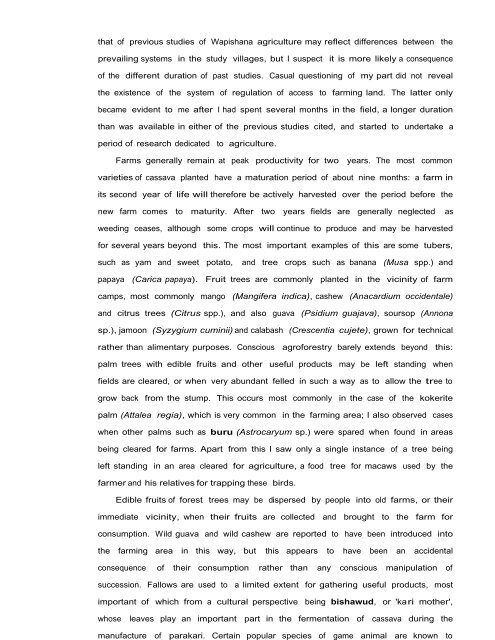Ethnoecology, Resource Use, Conservation And Development In A ...
Ethnoecology, Resource Use, Conservation And Development In A ...
Ethnoecology, Resource Use, Conservation And Development In A ...
Create successful ePaper yourself
Turn your PDF publications into a flip-book with our unique Google optimized e-Paper software.
that of previous studies of Wapishana agriculture may reflect differences between the<br />
prevailing systems in the study villages, but I suspect it is more likely a consequence<br />
of the different duration of past studies. Casual questioning of my part did not reveal<br />
the existence of the system of regulation of access to farming land. The latter only<br />
became evident to me after I had spent several months in the field, a longer duration<br />
than was available in either of the previous studies cited, and started to undertake a<br />
period of research dedicated to agriculture.<br />
Farms generally remain at peak productivity for two years. The most common<br />
varieties of cassava planted have a maturation period of about nine months: a farm in<br />
its second year of life will therefore be actively harvested over the period before the<br />
new farm comes to maturity. After two years fields are generally neglected as<br />
weeding ceases, although some crops will continue to produce and may be harvested<br />
for several years beyond this. The most important examples of this are some tubers,<br />
such as yam and sweet potato, and tree crops such as banana (Musa spp.) and<br />
papaya (Carica papaya). Fruit trees are commonly planted in the vicinity of farm<br />
camps, most commonly mango (Mangifera indica), cashew (Anacardium occidentale)<br />
and citrus trees (Citrus spp.), and also guava (Psidium guajava), soursop (Annona<br />
sp.), jamoon (Syzygium cuminii) and calabash (Crescentia cujete), grown for technical<br />
rather than alimentary purposes. Conscious agroforestry barely extends beyond this:<br />
palm trees with edible fruits and other useful products may be left standing when<br />
fields are cleared, or when very abundant felled in such a way as to allow the tree to<br />
grow back from the stump. This occurs most commonly in the case of the kokerite<br />
palm (Attalea regia), which is very common in the farming area; I also observed cases<br />
when other palms such as buru (Astrocaryum sp.) were spared when found in areas<br />
being cleared for farms. Apart from this I saw only a single instance of a tree being<br />
left standing in an area cleared for agriculture, a food tree for macaws used by the<br />
farmer and his relatives for trapping these birds.<br />
Edible fruits of forest trees may be dispersed by people into old farms, or their<br />
immediate vicinity, when their fruits are collected and brought to the farm for<br />
consumption. Wild guava and wild cashew are reported to have been introduced into<br />
the farming area in this way, but this appears to have been an accidental<br />
consequence of their consumption rather than any conscious manipulation of<br />
succession. Fallows are used to a limited extent for gathering useful products, most<br />
important of which from a cultural perspective being bishawud, or 'kari mother',<br />
whose leaves play an important part in the fermentation of cassava during the<br />
manufacture of parakari. Certain popular species of game animal are known to


